CCP Red Culture Clash: The feudal Dalai-Lama-Tibet is dead, long live ESG-Xizang for Gen Z and the Global South, fight against Disney and for the national religions as cultural heritage
Well, the Goethe-Institute could learn a lesson from the cultural work of the KP China. Digital ambassadors, not to say digital cultural heritage ambassadors. The Terracotta Army and other historical figures as China’s Viral Ambassadors. Xi Jinping’s Global Civilizational Initiative digitized and very innovative. Will there be a digital Goethe or Marx or any other historical cultural figure from the USA or Germany? According to the Global Times article, the target group is also the youth, Gen Z who are now also introduced to virtual reality for the time being using modern digital technology to learn about the cultural heritage of the nation or previous dynasties and the history of its empires in the context of national rejuvenationand the Chinese dream to let the Middle Kingdom and the imperial world power China become real and analogue as their future task in the future by 2049 at the latest.
“NW China’s Shaanxi Province introduces digital ambassadors
Four figures diversify presence of rich history
By Lu Wenao Published: May 24, 2023 10:28 PM
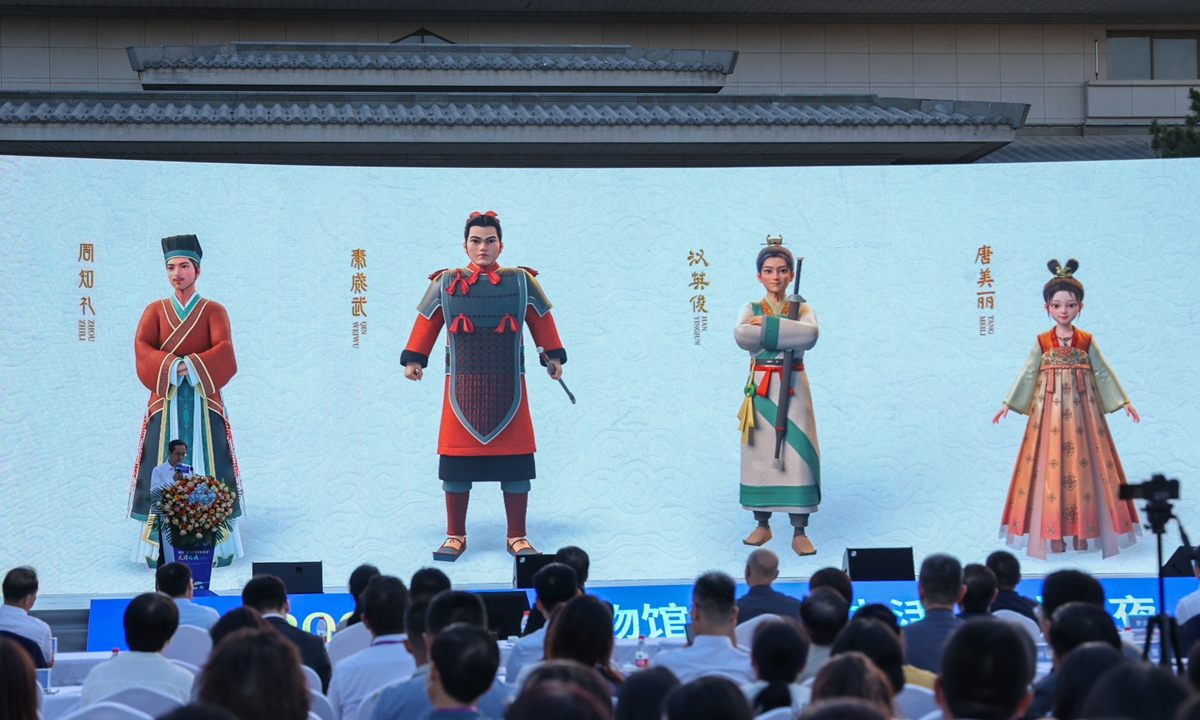
Photo: IC
Earlier this week, the Shaanxi Provincial Cultural Heritage Administration introduced four digital ambassadors as part of its bid to strengthen its digital presence.
A cultural powerhouse, Northwest China’s Shaanxi Province is renowned for its rich cultural heritage and deep historical roots. The capital city Xi’an served as China’s capital for 13 dynasties, including the Western Zhou (1046BC-771BC), Qin (221BC-206BC), Western Han (206BC-AD25) and Tang (618-907) dynasties.
Zhou Zhili, Qin Weiwu, Han Yingjun and Tang Meili are the names of the four digital characters that respectively represent the Zhou, Qin, Han and Tang dynasties.
„Making cultural elements an active part of the internet is vital for the preservation of cultural heritage nowadays,“ Guo Peihui, an official with the Shaanxi Provincial Cultural Heritage Administration, who oversees the digital ambassador program, told the Global Times on Wednesday.
„Digital characters are popular among the young generations. They can help make history and cultural elements easier to understand.“
The digital characters have been crafted to embody the distinct characteristics of their respective eras. For instance, their names in Chinese represent the different cultures of the dynasties.
„Aligning the characters‘ names with their respective personalities and cultural roles can also boost the popularity of the culture of these various dynasties,“ Guo noted, adding this approach aims to enhance people’s cultural perception and facilitate effective cultural dissemination.
As one of the cradles of ancient Chinese civilization, Shaanxi, whose cultural significance and contributions to Chinese history are unparalleled, boasts a wealth of cultural treasures and a profound historical legacy, from the iconic Terracotta Warriors to the ancient Silk Road. This has granted Shaanxi a pivotal role in shaping China’s cultural and historical landscape.
The four digital figures could diversify the way the province’s rich history is presented and is sure to be more effective than relying on one single figure.
„Using one single character will limit the way we can present things digitally, as coordinating the four characters can make interactions with audiences more captivating,“ Guo said.
The digital ambassadors will utilize cutting-edge technology to transcend the limitations of time and space, said Guo, as the characters are expected to have a range of abilities to engage with the audience and offer immersive cultural experiences.
While the virtual characters are still in the early stages of development, their envisioned applications include interactive conversations, presenting historical information, showcasing traditional rituals or customs through animated works and participating in livestreaming broadcasts and programs, Guo said.
Analysts say the virtual characters can bridge the gap between online and offline experiences, attracting more visitors to visit cultural institutions and expanding the boundaries of marketing and cultural tourism, thus fostering a new ecosystem for the cultural industry.
„The project will not only enrich cultural experiences but also propel the development of the cultural industry, combining heritage preservation with utilization and fostering the growth of the cultural creative industry,“ a Beijing-based cultural expert told the Global Times on Wednesday.
„Their future integration into exhibitions and interactive experiences can diversify the way people learn about and appreciate history. By combining the power of storytelling, technology and cultural preservation, putting modern elements into ancient cultural resources could help make our cultural heritage more vibrant both online and offline,“ said the expert.
https://www.globaltimes.cn/page/202305/1291318.shtml
The debate about diversity and inclusivity of minorities or other “races” is now reaching China. The Little Mermaid adaptation, now with an African-American mermaid and brown skin, has been met with criticism. Is it because a “negress” was chosen instead of an Asian? That would probably be too much admission of one’s own Han Chinese racism and one does not want to be accused of that. Therefore, the criticism starts at another level: whether the historical narrative should simply be changed from classic formats through quotations and the classics should be alienated, which would alienate it from the original. Classics should be classics, originals should remain originals, rather historical documents of the time, the maybe progressive content and its magic should also be understood from its time and Hans Christian Andersen and the Little Mermaid remain Hans Christian Andersen – regardless of the white skin color – unadulterated und unchanged as children know him and her since childhood. Which is not wrong, but on the other hand would put a stop to any modern adaptation. According to this, Richard Wagener’s „Ring der Nibelungen“ /Ring of the Nibelungs should only exist in Bayreuth in the traditional original version and not in any of these Schlingensief versions or in the fashion of serving any zeitgeist trends, which would sometimes be more pleasant. Instead, one should rather write new stories that deal with the real perspectives of other minorities/races and their problems including racism and not color the originals. The seriousness of the motive of inclusion and diversity in the West/USA/Hollywood/Disney are questioned, also whether this serves economic motives and opportunistic use of fashionable trends or is seriously against racism. Interesting that Desantis is currently attacking Disney as part of his Antiwokeness campaign. Disney now under criticism from two sides—the CCP and the unwoken US right. It will be interesting to see when Sinowood will make the first Uyghurs and Tibetans or Mongolians the film hero and their problems with Hanchauvinism and racism as a topic, or then perhaps ask Disney to have a Chinese or, more pan-Asian, an Asian as the protagonist. Marvel’s The son of Fu Manchu or Disney’s Mulan wasn’t what the CCP imagined either. Maybe Bollywood will surprise you with new storytelling.
“‘The Little Mermaid’ shows Disney’s lazy storytelling strategy
By Global Times Published: May 25, 2023 12:15 AM

Illustration: Hang Dachuan/Global Times
Disney’s live-action adaptation of The Little Mermaid is set to be released in the Chinese mainland on Friday, the same day as North America. The film, featuring African-American actress Halle Bailey, has caused a debate about representation in entertainment and highlighted the challenges of adapting beloved, traditional tales.
Currently, The Little Mermaid has received mixed reviews in North America, with a 70 percent fresh rating on Rotten Tomatoes but only a 42 percent fresh rating from top media outlets. Additionally, the film’s Metacritic score has dropped from an initial 61 to 59.
Many who have watched the film during pre-screenings have criticized Disney for lacking imagination and misinterpreting the essence of what made its original children’s film successful.
The rather „poor rating“ looks like its performance in China is not optimistic.
Current pre-sales plus pre-screenings is about 410,000 yuan ($58,193) in the Chinese mainland, and the screen rate for its debut has also dropped from 30 percent to 13 percent.
Many Chinese netizens said that like „Snow White,“ the image of the mermaid princess in Hans Christian Andersen’s fairy tales has long been deeply rooted in their hearts, and it takes a leap in imagination to accept the new cast.
Similar sentiments were echoed by Japanese audiences, with rumors that the comment section on the film’s presale page was disabled due to a backlash. Based on these reactions, it seems unlikely that The Little Mermaid will perform well in East Asian markets.
Disney’s decision to cast a person of color as the lead in The Little Mermaid seemingly was made to break stereotypes and promote equality, but so far, the negative reactions outweigh the positive ones.
This begs the question of whether Disney’s „political correctness“ actions are motivated by capital interests or genuine concern for representation.
Despite the controversy, The Little Mermaid has generated significant buzz online, with the trailer receiving record-breaking views and even inspiring viral videos featuring an AI actress.
According to media reports, the first full trailer promoting The Little Mermaid generated more than 108 million global views in its first 24 hours, making it one of the most watched trailers for any title in Disney’s growing stable of live-action reimaginings, and the biggest for a Disney live-action title since The Lion King in early 2019.
Moreover, the film’s controversy has garnered attention and created a new discourse around classic fairy tales.
Karey Burke, president of Disney’s General Entertainment Content, once vowed to have more inclusivity in the company’s productions – as the entertainment giant works to make underrepresented groups, such as racial minorities, account for at least 50 percent of its regular characters by the end of 2022.
Whether Disney’s „politically correct“ actions are misguided or genuine is up for debate, but it is clear that the film’s controversy has created a new discourse around classic fairy tales and their place in modern society.
The Little Mermaid is just one example. The new Peter Pan and Wendy features a black actress as the fairy Tinker Bell and the live-action adaptation of Snow White stars a Latina actress.
The controversy surrounding Disney’s forced inclusion of minorities in classic films is not about racism, but its lazy and irresponsible storytelling strategy.
If the company truly wants to represent marginalized groups, why not create original stories that reflect their experiences instead of turning classic tales into „sacrificial lambs“ for political correctness?
When the beautiful stories that have accompanied countless children’s childhoods become arenas for racial conflict, they lose their meaning and become devoid of romance and fantasy, replaced by arguments about skin color.
If Disney continues following this path, audiences, especially innocent children will no longer care if the „prince and princess live happily ever after,“ but „what is the skin color of the prince and princess,“ and the fairy tale will lose its magic glory.
https://www.globaltimes.cn/page/202305/1291330.shtml
The CCP also criticizes Disney as an anti-China force, since a Simpsons series criticized forced labor, which one felt addressed and suspected of a smear campaign for forced labor on the Uyghurs. The Simpsons are popular in China and around the world, but due to their political satire they are often the victims of censorship or angry protests in authoritarian countries like China, most recently when the Simpsons traveled to China as they wanted to adopt a little Chinese girl. Now again excitement because of the subject of forced labor, respectively: Uyghurs. In the opinion of the Global Times Disney should better refrain from doing this and think of its profit calculations in the Chinese cinema supermarket and bring more pleasant topics.
Disney’s ‚Simpsons‘ episode smearing China doomed to backfire: experts
By Global Times Published: Feb 08, 2023 11:35 PM

Tourists visit the sand sculptures based on American animated sitcom The Simpsons at Haeundae Beach in Busan, South Korea on May 25, 2017. 10 sand sculptors from 6 countries will demonstrate their skills during a sand sculpture festival from May 26 to 29 at Haeundae Beach. Photo: CFP
After Disney removed a Simpsons episode smearing China from its streaming service in the Hong Kong Special Administrative Region, experts warned on Wednesday that untrue content is a self-defeating move and Disney should better manage its products for the sake of sustainable development in China.
A recent episode of the American cartoon series The Simpsons wantonly smeared China, with a clip referring to the “forced labor camps” in China fabricated by anti-China forces, according to media reports.
The episode, named One Angry Lisa, contains a scene of about 10 seconds in which a character, over images of China’s Great Wall, says “behold the wonders of China. Bitcoin mines, forced labor camps…”
The lines sparked criticism among netizens. A netizen wrote on Facebook that it is unethical and unprofessional. “Too many people rush to judgment based on prior hypothesis bias, and now the West leads the way and turns lies to ‘truth,’” he said.
Based on the US’ strong economic power, American cultural products have great influence across the world, but the influence is not the same as truth and justice, Dong Shaopeng, a senior research fellow at the Chongyang Institute for Financial Studies at Renmin University of China, told the Global Times on Wednesday.
It is a sign of the cultural penetration of anti-China forces in the US, Dong warned.
Anti-China forces in the West have been hyping rumors about “forced labor camps” in Northwest China’s Xinjiang Uygur Autonomous Region in recent years. China’s Foreign Ministry said they are seeking to undermine the prosperity and stability of Xinjiang and contain China’s development and revitalization under the pretext of human rights.
The cartoon series is produced by Disney-owned 20th Television Animation and airs on the company’s streaming platform Disney Plus, which is currently not available in the Chinese mainland. Though Disney has removed the episode from its streaming service in Hong Kong, users from many other regions, such as Australia and China’s island of Taiwan, can still watch it, according to a Financial Times report and Hong Kong media outlets.
Respect for the truth is the most basic requirement, Dong said, noting that wantonly smearing China will eventually backfire.
China has become one of Disney’s most significant sources of revenue for its films and theme parks.
The box office for its latest film – “Avatar: The Way of Water” – has exceeded 1.66 billion yuan in the Chinese mainland, according to data released by the box office tracker Dengta on Wednesday.
During the recent Spring Festival holidays, Shanghai Disneyland was packed with visitors. It took an hour just to get into the park, one netizen said on Chinese social media platform Xiaohongshu.
https://www.globaltimes.cn/page/202302/1285109.shtml?id=11
Apparently the CCP now wants to distract attention from Xinjiang by means of Tibet and show Xizang as a development model for the Global South as well, as whose leaders China and India behave in competition with each other. At the moment the majority of the world public connects Tibet first and foremost with the person of the Dalai Lama as the unofficial leader of world Buddhism, which is why he and Tibetan Buddhism are not mentioned at all and the CP China has now also deleted the word Tibet in its English-language publications and like in Chinese publications only talks about Xizang. Nothing more is heard from the Dalai Lama, especially since the Chinese Communist Party is quietly preparing for his death and replacing him with a Chinese candidate, Western human rights organizations not even talk about blatant human rights violations such as the Uyghur labor camps. Now Tibet is presented as the prime example of Chinese development achievements at a forum with foreign representatives. Allegedly many parts of Tibet have now been connected with bullet trains, infrastructure and roads. The Beijing-Lhasa route is now to be extended to Nepal – that’s probably why a representative of Nepal was at the Tibet Forum. Interestingly, the Indians now also want to build a New Delhi-Katmandu railroad/broad gauge/diesel. But they don’t have to build across the Himalayas like the Chinese, who probably want electric trains with a different gauge. Let’s see who will advance to Kathmandu first, especially since it could then also be used for troop transport like the Baghdad railway instead of just for Hindu and Buddha pilgrims along with tourists and business people. The message is: The feudalistic Dalai Lama Tibet is dead, long live the ESG (Ecology, Social, Good governance) – Xizang as a successful province of China with people’s happiness and gross national happiness like the Buddhist Bhutan. In Tibet then as Xizang no longer God governance by a Dalai Lama and Tibetan Buddhism, but good governance by God Xi and his thoughts. The Hans Seidel Foundation of the CSU also joins the chorus of admirers like Strauss once did with Mao:
“Xizang’s vitality, prosperity shine at key development forum
‘People’s happiness the ultimate human right; development key to it’
By Zhang Han, Shan Jie , Yin Yeping and Fan Wei Published: May 23, 2023 11:05 PM Updated: May 23, 2023 11:40 PM
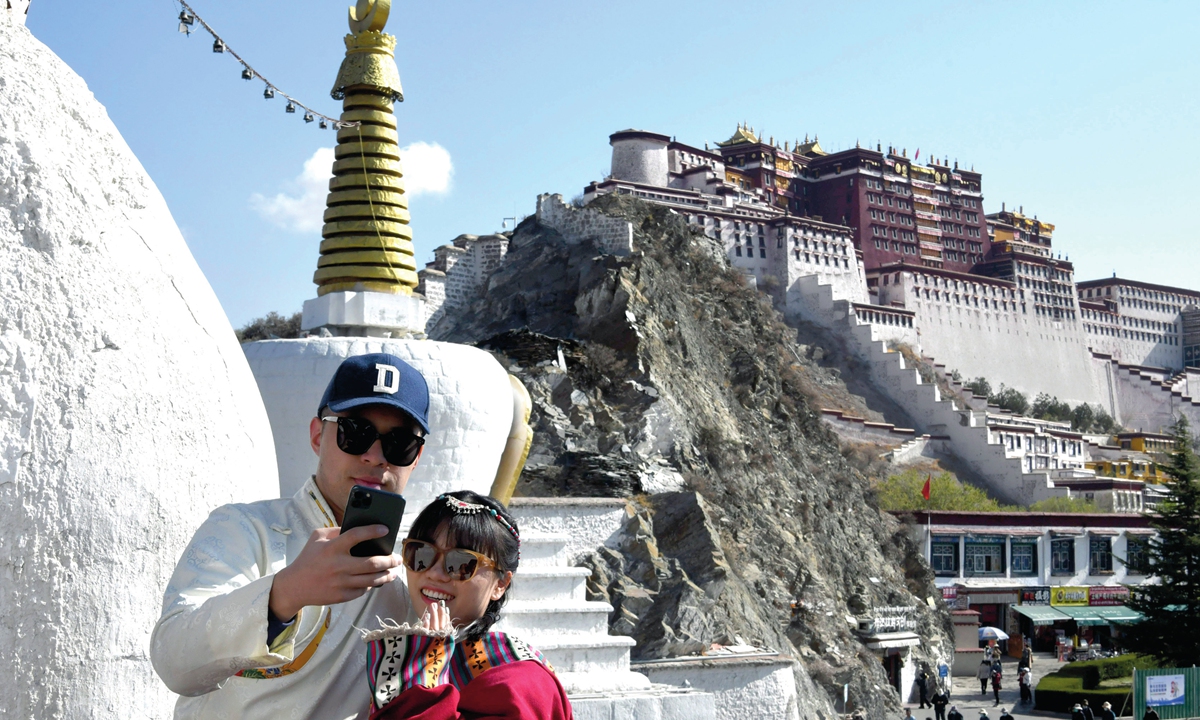
Tourists dressed in ethnic clothing take pictures in front of the Potala Palace in Lhasa, Southwest China’s Xizang Autonomous Region on April 17, 2023. Photo: VCG
People’s happiness is the ultimate human right, while development holds the key to delivering better lives to the people, Chinese President Xi Jinping said in his congratulatory letter to „2023 Forum on the Development of Xizang, China“ held in Beijing on Tuesday, May 23, the 72nd anniversary of the region’s peaceful liberation.
Since the 18th National Congress of the Communist Party of China (CPC) in 2012, people in Xizang, with the strong support of the central government and people throughout the country, have worked with fortitude and brought about a resolution to the problem of extreme poverty that had plagued the region for centuries, the letter said. Xizang has achieved a moderately prosperous society in all respects along with the rest of the country, demonstrating vibrant and thriving scenes.
The vitality and prosperity of Xizang not only impressed more than 150 diplomats, scholars and industry representatives from 36 countries and regions at the Tuesday forum, but also constituted a loud rebuttal to some groundless attacks and smears against China’s policy and governance in Xizang.
Li Shulei, a member of the Political Bureau of the CPC Central Committee and head of the Publicity Department of the CPC Central Committee, also delivered an address to the Tuesday forum.
The Global Times learned from the forum that Xizang’s GDP and GDP per capita reached 213 billion yuan ($30 billion) and 58,438 yuan in 2022, a jump of 347 and 110 times from the time of peaceful liberation 72 years ago. People’s life expectancy doubled from 35.5 years in 1959, the time of democratic reform, to 72.19 years today. People in Xizang enjoy free education for 15 years.
The numbers are the best illustration of Xizang’s achievements in development and human rights protection, said Yan Jinhai, Deputy Secretary of the CPC Xizang Autonomous Regional Committee and Chairman of the People’s Government of Xizang Autonomous Region.
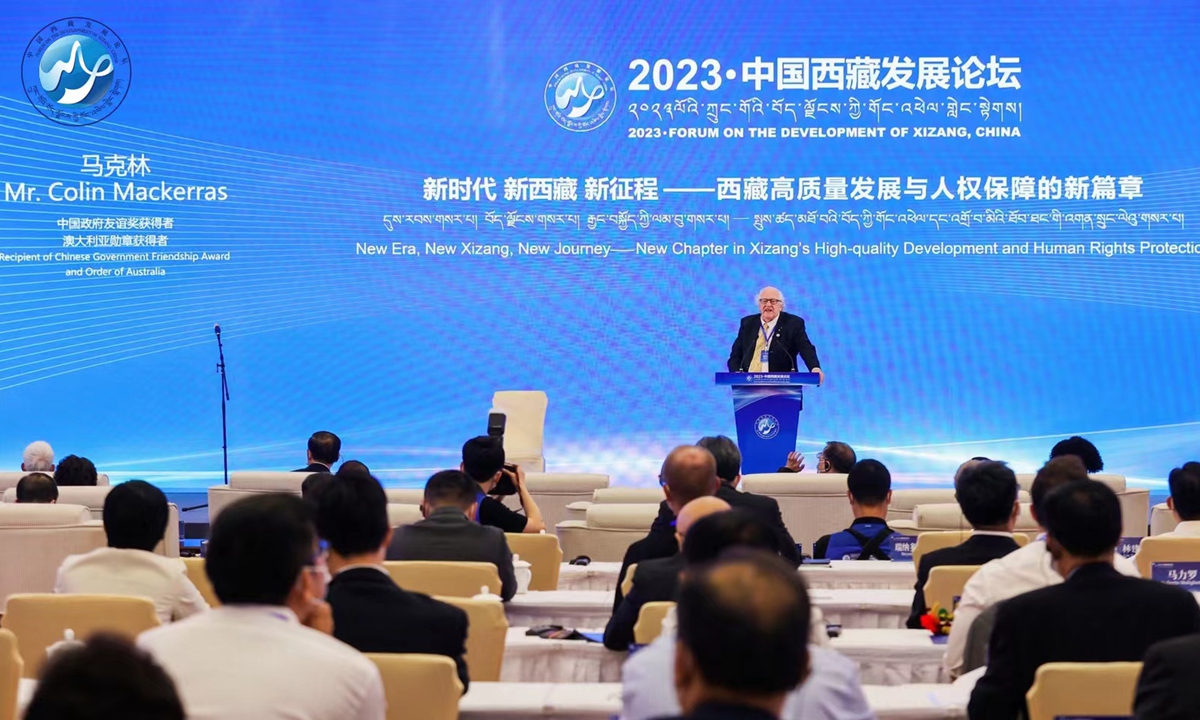
The 2023 Forum on the Development of Xizang, China kicks off in Beijing on May 23, 2023. Photo: Zhang Han/ GT
Impressive achievements
After visiting Xizang Autonomous Region, foreign delegates hailed the region’s modernization from infrastructure progress to economic leaps, while being impressed by the effective protection of local culture and ecological preservation.
The delegation took a high-speed train from regional capital Lhasa to Nyingchi, Xizang’s first electrified railway that opened in 2021. Many forum attendees mentioned the experience to the Global Times as a vivid example of Xizang’s high-quality development.
In Xizang, remote cities are connected through bullet trains, roads and other transportation, which established the basis for economic development, Nepali Ambassador to China Bishnu Pukar Shrestha told the Global Times at the event.
Maria Gustava, the Mozambique Ambassador to China, in her speech at the forum opening ceremony hailed a modern Xizang that has well-connected infrastructure as well as advanced telecommunications systems, including 5G internet.
Gustava told the Global Times that through Xizang’s development miracle of poverty alleviation, she saw the philosophy of inclusiveness – each region should develop based on its own conditions and protect and preserve local cultures. African countries can learn from China’s experience and further cooperate on poverty reduction and rural development, she said.
Alexander Birle, chief representative of Germany’s Hanns Seidel Stiftung in China, told the Global Times on Tuesday that Xizang’s development focus is not only on the economic aspect, but also ecological protection and the preservation of cultural relics and heritage.
Xizang is a strategic national ecological security barrier and a national experimental area for green development. Efforts include monitoring of glaciers, constructing national parks and reserves, accelerating the green transformation in industry and society and preserving the invaluable land, according to the forum.
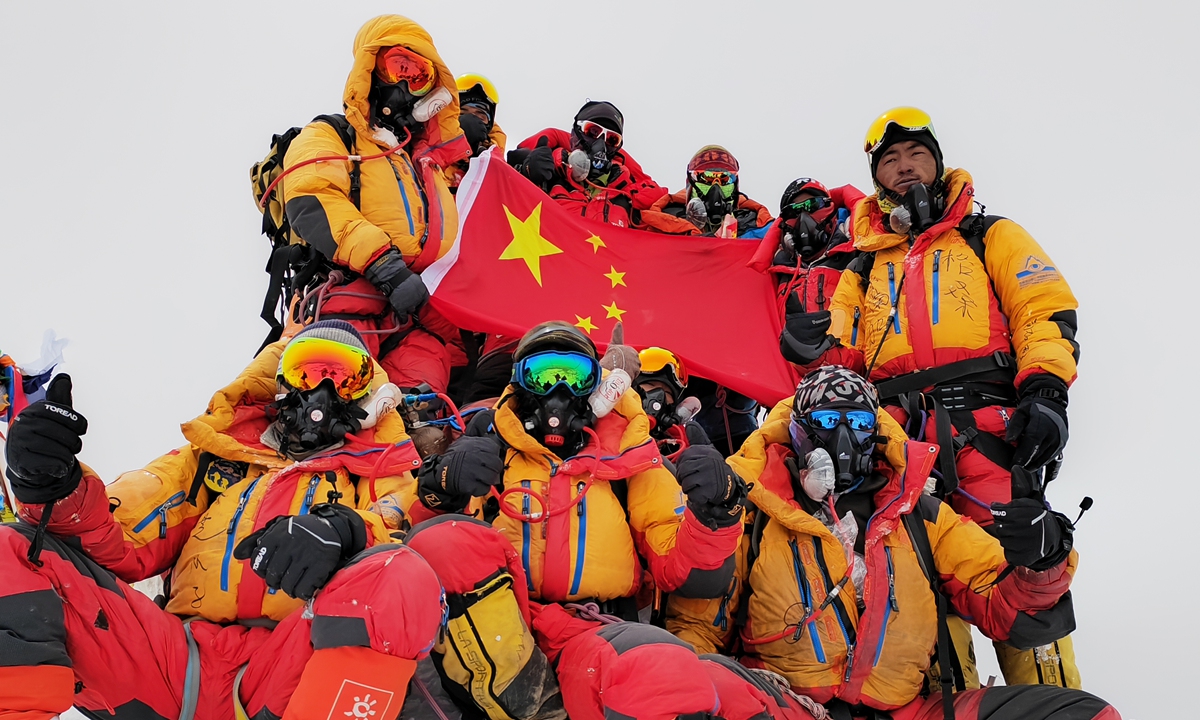
Thirteen Chinese scientists display the Chinese national flag on the summit of Mount Qomolangma after reaching the summit on May 23, 2023. After that, they are expected to complete important scientific tasks such as collecting snow and ice samples from the summit. This is the first time that China’s Everest expedition has reached an altitude above 8,000 meters since 2022. Photo: Xinhua
Breaking stereotypes
The development of Xizang is evident for all to see, yet it has always been accompanied by noises from the outside world. Some Western media or politicians turn a blind eye to the facts of Xizang’s development and instead engage in deliberate slander. Some arguments are baseless and merely serve as a tool to attack China.
One recent clamor from the West and anti-China forces revolves around accusations leveled at boarding schools in Xizang. Recent reports claim that „the Chinese government is attempting to eradicate Tibetan culture altogether.“
However, the Global Times visited boarding schools in Xizang at the end of March, and the reality is quite different – Tibetan language education and the preservation of traditional culture are integral parts of education in Xizang, and they are well-reflected in boarding schools.
Boarding schools are suitable for Xizang’s unique geographical environment as they provide formal education to students from remote areas, holding significant importance in nurturing more talents locally.
Vikash Kumar Singh, a lecturer at the Asia Institute of Beijing Foreign Studies University from India, told the Global Times on Tuesday that people in Xizang stick to their own traditions and culture, like their dances, music, food and Thangka painting, in opposition to Western claims that Xizang culture is in danger.
Xizang is keeping its traditions while developing, and Xizang people also have the right to offices with air conditioning, cinemas and bullet trains, Singh said.
The „Tibetan government-in-exile“ and some overseas anti-China organizations try to use religion, „human rights“ and other topics to undermine social stability in Xizang, but Abdilahi Ismail Abdilahi, a teacher at Beijing Foreign Studies University from Somalia said „When you arrive in Xizang, you can realize that everything is different from what you have heard in some media.“
„As long as you get to Xizang and see with your eyes, you could realize what is going on in Xizang,“ he said, noting that the experience of Xizang’s development could also inspire that in African countries.
Guillaume Guibe, a French employee of China Petroleum & Chemical Corporation said that the criticisms and stereotypes in the West about Xizang come out of ignorance. „They [some people in the West] just hear some stories about Xizang and do not check these stories,“ Guibe said. „I wish they could someday visit the region by themselves.“
Zhang Shuhua, director of the Institute of Political Sciences at the Chinese Academy of Social Sciences, told the Global Times at the forum that some concepts, including human rights and democracy, are used by anti-China forces deliberately to attack China’s governance.
China’s human rights should be understood in the broad context of the success of China’s governance, which is realized by sticking to a political path suitable for historical and cultural conditions, by upholding the leadership of the CPC to ensure that its governance always has a stable political core, and by adhering to the „people-centered“ principle, Zhang shared at the forum.
As long as sound governance continues to bring substantial development in Xizang and the rest of China, all attacks on human rights and democracy would fall through, analysts said.

GT Graphics
https://www.globaltimes.cn/page/202305/1291241.shtml
But Xizang is not just a matter for adults, it is also a generation concern and a mega task for the Chinese Generation Z. Because there was also a special forum for them. Probably the state-initiated FFF variant Fridays for Xizang. Tibet now as a climate protection project for Generation Z – whether Chinese or Tibetans is not said. In any case, Tibet is blessed with plenty of sun, hydroelectric power and coal and they want to expand renewable energy there. Create national parks that protect biodiversity, deter invasive animal species and do something against the melting of glaciers. Of course, Generation Xi could do something to protect the climate very quickly if they make China´s development without the additional planned hundreds of new coal-fired power plants and sacrifice some economic growth, but this would not lead to a debate and would transform anyone who voices this position into an opposition member or dissident with known treatment by China’s State Security:
“Gen Z could play significant role in Xizang’s sustainable development: forum
By Shan Jie
Published: May 23, 2023 09:55 PM
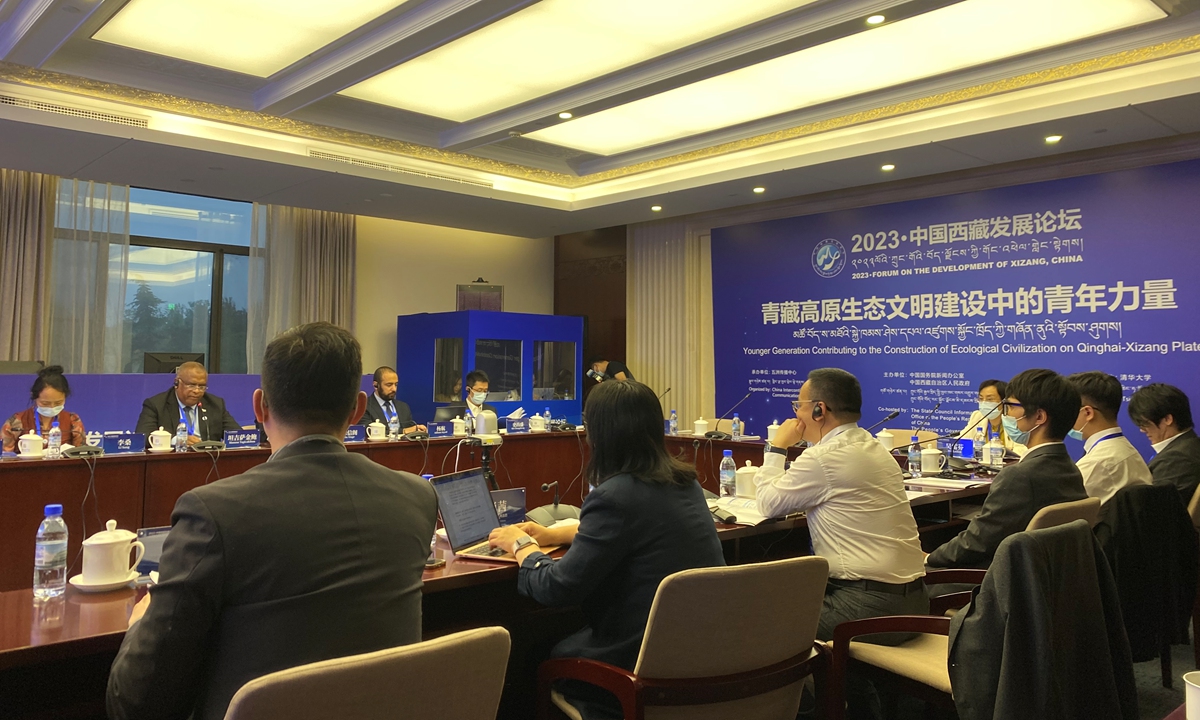
Experts and young scholars share their opinions on the topic of „Younger generation contributing to the construction of ecological civilization on Qinghai-Xizang plateau“ at a side event at the Forum on the Development of Xizang held on May 23, 2023 in Beijing. Photo: Shan Jie/ GT
The younger generation is actively engaged in the conservation of the ecology and environment in Southwest China’s Xizang Autonomous Region, and many more Gen Z people with diverse skills and abilities are expected to contribute and take on significant roles in this endeavor.
Environmental authorities, experts and young scholars shared their opinions on the topic of „Younger generation contributing to the construction of ecological civilization on Qinghai-Xizang plateau“ at a side event at the Forum on the Development of Xizang held on Tuesday night in Beijing.
„The young generation should be guided well in terms of preserving ecology, because the ecology gives back to them,“ Manasa Tagicakibau, Ambassador of Fiji to China, told the Global Times at the event.
The ambassador noted that both the South Pacific and Xizang are vulnerable to climate change. „We have frequent storms, tropical cyclones that are happening more frequently and with greater intensity now due to climate change, while glaciers are melting in Xizang, causing the sea level to further rise,“ he said.
The responsibility and practice of „Generation Z“ in promoting environmental protection and sustainable development in the Qinghai-Xizang Plateau are crucial to the future of the region and the planet as a whole, Jennifer Holstein, principal of the International Education School of Pingo Academy, said.
„Generation Z can make a significant impact on the environment and contribute to a more sustainable future. It is up to this generation to take action now to ensure that the Qinghai-Xizang Plateau remains a vibrant and healthy ecosystem for generations to come,“ she said.
Xizang has seen achievements in ecological protection, and it is expected to benefit more from the process of green development.
„Xizang is blessed with abundant natural resources. It holds a unique advantage in terms of hydroelectric and solar energy potential, with the highest development capacity and carbon sequestration capacity in the country,“ Yan Jinhai, Deputy Secretary of the Communist Party of China Xizang Autonomous Regional Committee, Chairman of the People’s Government of Xizang Autonomous Region, said in his plenary speech at the forum.
In the future, there is a strong possibility of establishing a clean energy base with a total capacity of more than 300 million kilowatts. This would provide trillions of kilowatt-hours of clean electricity to the nation annually, contributing to a reduction of approximately 1 billion tons of global carbon dioxide emissions.
Xizang is home to the most developed mountain glaciers, abundant rivers, and lakes. It is one of the world’s three major pristine regions, with large parts of the area still in its original state and numerous ecological secrets yet to be unveiled, Li Sang, Vice Party Secretary and Director General of the Ecological Environment Department of Xizang Autonomous Region, said at a sub forum on Tuesday.
Xizang will promote the establishment of the Three Rivers Source National Park (Tangbei region) and facilitate the development of national parks such as Qiangtang and Mount Qomolangma. Efforts will be made to enhance the protection and management of biological genetic resources while strictly controlling the invasion of alien species, according to Li.
https://www.globaltimes.cn/page/202305/1291227.shtml
For the central future task of Gen Z in the conflict and propbale kynetic clash with the USA, the last supposed victory of China’s PLA against the US military in the Korean War is also commemorated in another movie and the population is now inoculated with a new war rind of patriotism and willingness to make sacrifices for the fatherland. The pride in the red culture is also emphasized.
Action epic to bring heroism in Korean War to modern era
New war film inspired by pivotal blockade battle
By GT staff reporters Published: May 22, 2023 11:22 PMhttps://www.globaltimes.cn/page/202305/1291164.shtml
In order to give the apparently somewhat frustrated parts of the Gen Z youth with “No Future” and “No Bock” tendencies some guidance and “to create meaningful offers”, the CCP have now shot their own propaganda film “Burning Youth” and how according to the Chinese Communist Party, Gen Z has to look like as the new ideal-typical youth pioneers. From the panda breeder to the insular guardian of the South China Sea to the taikonaut, everything is offered and presented as a role model and Gen Z´s future. Are there films like this in the West? Maybe it goes beyond German programs like“Youth is researching (Jugend forscht) ”, internship exchange fairs and Girlie Day and maybe as part of the turning point (Zeitenwende) of the century a state propaganda film about dream jobs from soldiers to reconstruction workers in the Ukraine is then the topic, since this also shall be, a „generational task” according to Scholz.
“’Burning Youth‘ puts China’s Generation Z in the spotlight
New variety show tells ‚dare to dream‘ stories
By Xu Liuliu
Published: May 04, 2023 10:44 PM
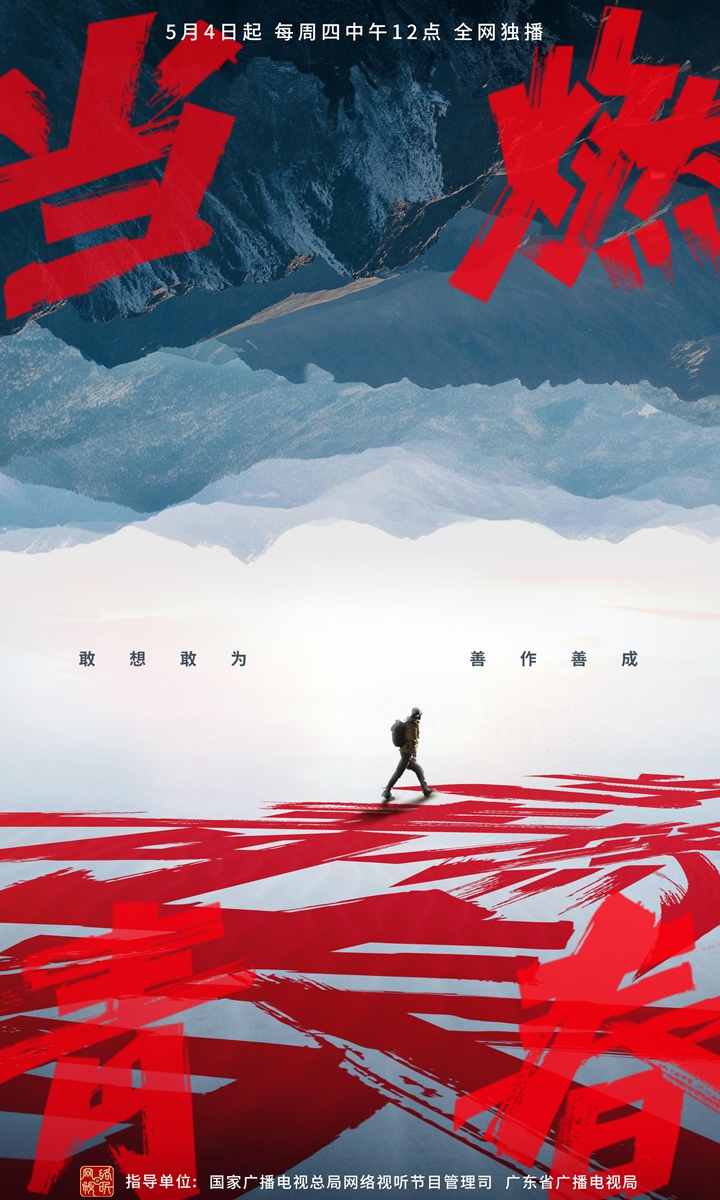
Photo: Courtesy of Tencent Video
Young panda breeders whose daily job is to prepare three meals a day for these cute creatures, conservationists who dive under the waters of the South China Sea to tie coral to the seedbed and soldiers who guard the border in Southwest China’s Xizang Autonomous Region… They are some of the millions of China’s Generation Z who are daring to dream and take action.
Burning Youth, a new variety show focusing on these stories, debuted on streaming platform Tencent Video on Thursday, China’s Youth Day.
„They are just ordinary people living among us,“ show producer Zhang Wei told the Global Times.
According to its director Wang Ning, each episode focuses on different themes, such as „Dreams,“ „The path toward dreams“ and „Our choices,“ presenting two to three stories that expand on these themes.
„Each youth story aims to grab the public’s attention. A story ‚finder‘ will ‚walk through‘ the story and introduce it to audiences. With this approach we are striving to find a means of presentation that young people love to see and that can present the depth and breadth of each story,“ Wang said.
Stories will focus on people like Yang Cen, the youngest female large-diameter shield machine driver in China, and Deng Manqi, daughter of Chinese taikonaut Deng Qingming and an assistant engineer at the Beijing Aerospace Control Center.
The „Our choices“ theme will introduce the stories of Dou Xiaoxuan, a national first-class actor from the Mei Lanfang Peking Opera Troupe at the Beijing Peking Opera Company; Wang Xiuzhen, who built the largest passion fruit sorting and sales center in her county; and the Saihanba forest rangers, who turned a wasteland into a forest in North China’s Hebei Province.
The show aims to be an exploration variety show that observes and records the inspirational stories of young people. Through the unique youth perspective of young people, it extracts the youth stories of „dare to think and to do and doing it well,“ and presents all walks of life to work hard for the motherland.
According to Yin Hong, a professor at the School of Journalism and Communication of Tsinghua University and vice chairman of the China Literature and Art Critics Association, a variety show should convey positive energy and mainstream values while combining entertainment and education.
„The show uses relatively unfamiliar themes to arouse empathy in viewers as they watch ordinary young people use their lives and youth to write valuable stories,“ he said.
„That is a very good basis for high quality content, which requires creators to discover truth, goodness and beauty in life and turn to themes that lead people upward, toward goodness and to chase beauty. These three are the most valuable things in life.“
https://www.globaltimes.cn/page/202305/1290145.shtml
Because the Chinese Gen Z generation seems to have a lasting interest in other things, especially in Tiktok and influencers with destructive behaviors and lifesstyles that do not please the CCP´s tastes, would probably also cause offense by parents and society in the West, while the German China basher newspaper BILD once again uses this as an argument against the Chinese competitor for US influencer platforms Tiktok and pretends that binge drinking and coma drinking were a a Chinese or even Asian unique selling point among many young people:
„Alcohol excess on TikTok: Chinese dies after drinking live stream

Deadly drinking orgy on TikTok!
The Chinese Internet star Wang Moufeng (34), better known as „Brother Sanqian“, is dead. He is said to have drunk a lot of liquor during a live stream competition last Tuesday and died from it, reports the British BBC. All of this happened on Douyin – the Chinese version of TikTok. The influencer was found dead in his apartment 12 hours after his stream. Wang’s death could most likely be the result of alcohol poisoning. His funeral took place on Saturday. „By the time his family found him, he was already dead. He didn’t even have the chance of emergency treatment,“ a close friend told Shangyou News.
In China, high-proof alcohol is usually used. During his stream, Wang drank the colorless liquor Baijiu, which contains up to 60% alcohol. Baiju is usually poured into thimble-sized shot glasses. However, Wang is said to have drunk at least seven full bottles during his binge, viewers report. For comparison, a bottle of Jack Daniel’s whiskey has an alcohol content of 45%. What was the competition about? Wang took part in four so-called „one-on-one battles“ last Tuesday. In the game, influencers cheer on their own community in order to receive as many virtual gifts as possible. These are financed with real money. The player who gets more points in the shortest amount of time wins.
However, „Brother Sanqian“ lost three of the rounds and was forced to drink as punishment. Alcohol is strictly forbidden on Douyin. Wang himself had been banned for drinking alcohol several times in the past. With newly created user accounts, however, he repeatedly cheated his way back to the platform. About 44,000 people followed him until his death. Wang’s death is not an isolated case! Again and again Chinese influencers die during their work. In 2021, the streamer Yu Hailong (29) felt the same way. The streamer had become known through excessive eating. This dangerous trend from South Korea is called Mok-Bang.

In 2018, the live streamer „Dafei“, who was known for drinking alcohol and cooking oil in front of the camera, also died.
Now, after the campaign against celebrities and fan clubs in the Global Times, influencers are being addressed. The code of conduct described is so general that it could also have been written by the EU or the USA. It is interesting that the only specific case mentioned is a kind of Metoo allegation by an influencer about sexual harassment by a CEO. Apparently, after Peng Shuai, they now want to prevent a Metoo tsunami and other Chinese Weinsteins, Brüderles and Kachelmanns.
“Maintaining integrity great responsibility for influencers
By Global Times Published: May 23, 2023 10:12 PM

Illustration: Hang Dachuan/Global Times
The rise of influencers has transformed the way we consume content and engage with social media platforms. These individuals, often known as online celebrities, wield significant influence over their followers, shaping opinions and trends with a single post or video. However, with great power comes great responsibility, and it is imperative that we establish a code of ethics to guide these online personalities.
The recent case involving online influencer Xiaohuijun and her false allegations against a multi-channel network company highlights the need for online celebrities to adhere to legal and ethical standards.
The influencer, with 13 million online followers, accused the company’s CEO Sun Haoyu of sexual harassment and forcing her to sign a contract, prompting widespread attention and controversy.
This case serves as a stark reminder that we must differentiate between legitimate claims and baseless accusations. Upholding the principles of lawfulness, responsible speech and ethical behavior should be the fundamental requirements for anyone publishing contents on the internet.
Freedom of speech is essential, but it must be exercised responsibly, with consideration for the potential consequences of one’s words and actions.
The role of influencers in shaping public opinion cannot be underestimated.
Their vast followings and ability to sway trends and opinions have led to their exploitation by different online groups and communities. It is crucial to guard against the misuse of their influence and the manipulation of public discourse. Influencers should not allow themselves to be entangled in misinformation or become pawns in the hands of those with ulterior motives.
Compliance with laws and responsible speech should be the basic minimum standard. Influencers must recognize their role as influencers and understand the impact their words and actions can have on their followers. By becoming influencers, they have a responsibility to ensure that the information they share is accurate, verified, and aligned with legal and ethical standards. Only in doing so can they help create a healthier online environment built on trust, reliability, and transparency.
To prevent the proliferation of fake news and the spread of harmful rumors, it is essential for online influencers to verify the accuracy of the information they share before disseminating it to their audience. Fact-checking and critical thinking should become an integral part of their content creation process. By adhering to these principles, they can play a pivotal role in countering the spread of misinformation and promoting a culture of truthfulness and integrity.
Furthermore, influencers should be cautious about becoming involved in controversies without fully understanding the underlying facts and complexities of the situation. They should exercise restraint in making public statements or taking sides until all the relevant information has been thoroughly examined and verified. Premature judgments can lead to the perpetuation of falsehoods, further polarize public opinion, and damage their own reputation in the long run.
The abuse of influencer status and manipulation of public opinion should be strongly condemned. Internet influencers should resist the temptation to exploit their fame and influence for personal gain. Instead, they should use their platforms to foster meaningful discussions, raise awareness about important social issues, and inspire positive change. By doing so, they can set an example for their followers and contribute to the overall betterment of society.
The case of Xiaohuijun and the ensuing controversies emphasize the importance of upholding integrity and ethical conduct on influencers. Compliance with laws and responsible speech should be the fundamental principle on the internet. It is crucial for them to use their platforms responsibly, ensuring the accuracy and veracity of the information they share. By maintaining high ethical standards and resisting the misuse of their status, they can contribute to a more trustworthy and responsible online community.
https://www.globaltimes.cn/page/202305/1291232.shtml
I always thought China, like us, would suffer from a skills shortage due to a demographic gap, which is why the high figure of 20% youth unemployment in urban China is surprising. According to Professor Van Ess, it is as in Germany and some western countries also the result of over-academicization. But these youth won´t be long-term unemployed either. Are they really that worried about their future? Is this really a new popular piety, given that even many pre-Gaokao students used to visit temples to light some incense sticks for a good exam result? Or is the new thing that they are doing now after gaokao? Although apparently not only academics should be meant. Are the promises of prosperity and the prospects for the future eroding? The CCP doesn’t seem to find this particularly alarming yet either. Apparently the CCP does not believe that there could be a popular religious movement ala Falungpng with then 100 million members and demonstration in front of the Beidahe, especially since these pilgrims are not or do not appear to be organized. Conversely, the remaining underground network of the Falun Gong could try to start there. But it is also possible that the Chinese Communist Party channels this into its party-controlled People’s Buddhism and breeds well-behaved, obedient subjects who, in extreme cases, only burn or selfimmolate themselves. But that’s also how the Arab Spring started in Tunisia, but China is probably miles away from that.
“Unemployment in China: They don’t want to put children in this world
By Jochen Stahnke, Beijing Updated 5/21/2020
Happiness at last: Young Chinese light incense sticks at the Lama Temple in Beijing. If you show obedience, you rise – that is Beijing’s promise to its people. Young Chinese doubt it. Some start praying. The Lama Temple in central Beijing is packed with students. At the temple kiosk shop, the students pick up bundles of incense sticks, light them in a metal charcoal stove and wave the incense in all directions with folded hands. Some grin, but most look pretty serious. Then they go in front of the Hall of Infinite Happiness, kneel down and pray for a better future. The official unemployment rate among young Chinese in the cities has risen to 20.4 percent. Praying students are increasing in Beijing. The authorities apparently accept the burgeoning popular piety for the time being. It’s an outlet for growing concerns. Some wonder if hard work is still worth it.”
Now that the FAZ has also reported about 20% youth unemployment in China, as well as a new popular piety and visits of Chinese youth to temples, this is also taken into account. Buddhist-communist merchandising in the market economy with Chinese characteristics. Not just the traditional outdated shopkeepers for older Buddhists, but now also talismans, lucky charms, cups and whatever the young kitsch heart desires. But the prices for youth souvenirs are being criticized and whether one should expect that from young people of Gen Z, who were also damaged by the Corona lockdown, if one does not attribute their psychological damage as Generation Corona to state criticism of these measures, as the latest mass protests in China which brings the CCP to the conclusion thatthis is better canalized in temple visits and turning to opium of the people which seems to be tolerated for the time being. Apparently there are now increasingly younger temple visitors, as the FAZ report on China’s youth unemployment already claimed and even spoke of a new „popular piety“ among China’s youth and Gen Z. Also interesting that Tibet is now also chosen as a future model of development for Gen Z, also in terms of climate protection. Some sort of Friday for Future with Chinese characteristics state-initiated and controlled by the CCP.
“Chinese temples attracting young people with trendy, well-designed products
Getting creative
By Huang Lanlan in Shanghai Published: May 24, 2023 09:08 PM
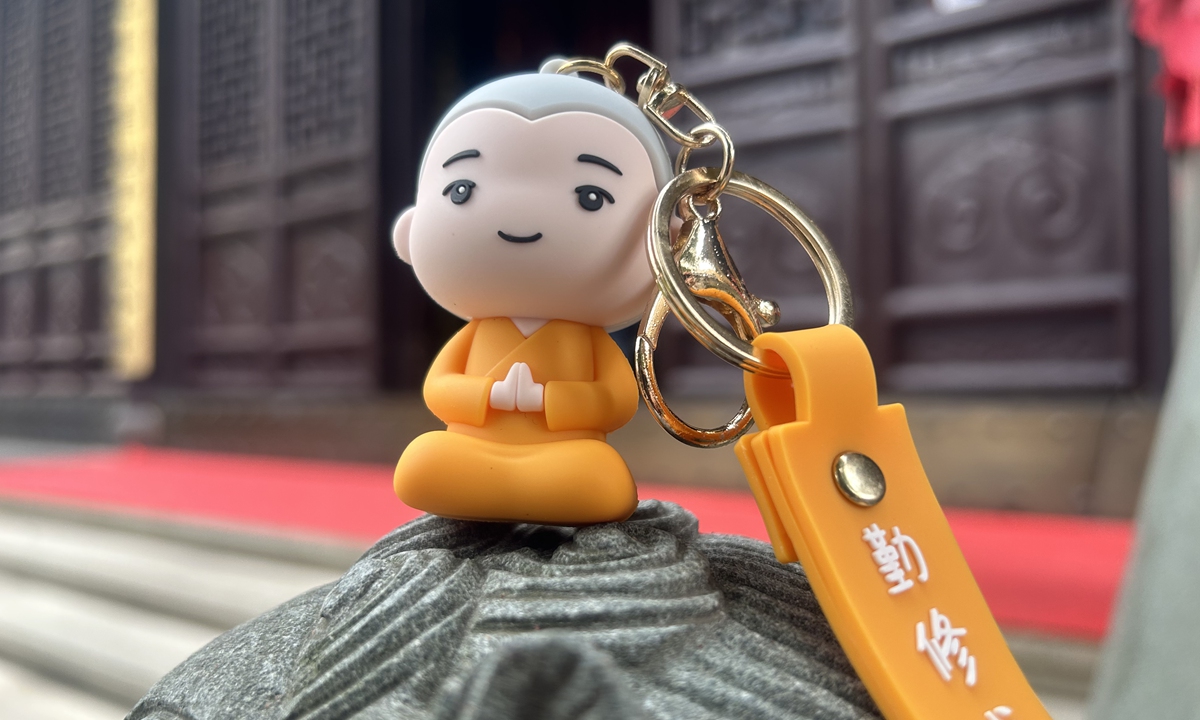
A key chain featuring the cartoon figure Shixiaobai on sale at the Yufo Temple in Shanghai Photo: Huang Lanlan/Global Times
To buy one of Yonghe Lama Temple’s beaded bracelets, Shanghai woman Liang Yu deliberately took time out during her busy business trip to Beijing to wait in line in the cold for more than an hour in front of the temple’s store.
It was an ordinary Monday afternoon in March when Yonghe Lama Temple’s beaded bracelets started gong viral on Chinese social media. The centuries-old Buddhist temple in downtown Beijing has been flooded with visitors even during the weekdays ever since. Including Liang, many of them waited in long queues to buy the popular bracelets, which they believed can bring them good luck, or at least help cheer themselves up.
Visiting temples has recently become a new trend among some young Chinese. They are motivated by such purposes as relieving stress or wishing for good fortune.
Due to this trend, many Chinese temples have started to offer creative and well-designed products to meet the tastes of young visitors.
Instead of the traditional items sold at temples, like Buddhist scriptures and amulets, new products include cups, pens and ornaments that have more secular uses, many of which cleverly combine Buddhism with designs such as cartoon figures and traditional Chinese culture.

Yonghe Lama Temple Photo: VCG
Bestseller bracelets
Liang bought 10 bracelets at the temple for herself and her friends that afternoon, each of which cost nearly 400 yuan ($56).
The temple offers several types of beaded bracelets in various colors that are supposed to improve people’s fortunes for things like their health, career and relationships.
„I bought one for my career,“ Liang told the Global Times.
She said that the Yonghe Lama Temple, the former residence of two Qing Dynasty (1644-1911) emperors, is generally believed to be a good destination for making career-related wishes.
More temple products are designed to directly serve people’s daily life nowadays.
Over the weekend at Yufo Temple, or Jade Buddha Temple, a famous Buddhist temple located in central Shanghai, visitors crowded in the temple’s store, selecting commodities piled up on the shelves such as ink pens, teacups and key chains.
Among the various products, a 99 yuan gift box for students is a bestseller, according to one shop employee. The box contains four ink pens, a silk sachet and a badge with a cartoon image of the Bodhisattva of Wisdom, Manjusri, on it.

Teacups featuring the cartoon figure Shixiaobai on sale at the Yufo Temple in Shanghai Photo: Huang Lanlan/Global Times
Traditional culture elements
Another popular cartoon figure sold at Yufo Temple is of a little monk named „Shixiaobai.“
„Shixiaobai is a cartoon character invented and designed for our temple’s products,“ the Yufo Temple shop employee told the Global Times.
Products sporting Shixiaobai have proven popular among younger customers, she added, pointing toward another big seller on the shelf – a 68-yuan teacup with Shixiaobai’s picture on it.
Similar to Yufo Temple, in recent years some other temples have designed cartoon characters for their products to attract younger customers.
One of the earliest and most famous characters is Xian’er, a cartoon monk originally created by Beijing’s Longquan Temple in 2011. Through the years, Xian’er has been used for various Longquan Temple-related products, from small ornaments to storybooks and even television cartoons.
Apart from cute cartoon images, traditional Chinese culture is also a major feature of recent temple creative products. The Wenshu Monastery, or Monastery of Manjusri, in Chengdu, Southwest China’s Sichuan Province, for instance, has launched a series of products made using intangible cultural heritage skills, such as a porcelain teacup wrapped in a woven bamboo cover, an intangible heritage item unique to Sichuan known as porcelain-bodied bambooware.
Chinese temples are moving with the times, said Buddhist enthusiast Bai Ze, who is also an independent temple product designer working with several temples in East China’s Jiangsu Province.
„As younger monks join temples, they bring new ideas, allowing temples to innovate their designs,“ Bai said.
Bai found that small-sized and good-looking products are a favorite of young customers.
„They are happy to pay for those beautiful and portable things with auspicious meaning,“ she told the Global Times.
Controversial prices
However, controversy has sometimes occurred with the going popularity of these creative products.
Grumbles about unreasonable prices are occasionally seen on social media. On the Twitter-like Sina Weibo, a user complained that she bought a rabbit-shaped key chain accessory for 88 yuan at a temple in Shanghai, but later found a similar item without the temple’s logo for only 10 yuan on a shopping website.
A few products even charge a „pink tax“ from female customers. Liang said the beaded bracelets she bought at Yonghe Lama Temple have men’s and women’s versions. „The women’s bracelets are smaller than the men’s, but they are sold at higher prices,“ said Liang, who founded nonprofit foundation Stand By Her to help women in need.
„That’s not fair.“
Temples are going commercial, which brings profit that allows them to keep running, but it brings new problems as well, Bai said.
Nonetheless, for most customers, price is not their top consideration when buying temple creative products, she added.
„They buy to wish for good fortune, or at least to get in a better mood.“
https://www.globaltimes.cn/page/202305/1291305.shtml
In any case, Muslim mosques in Xinjiang are now being closed and handed over to tourist purposes:
“Uighur mosques closed by Beijing, handed over for tourist use
By ATSUSHI OKUDERA/ Correspondent
October 15, 2020 at 19:15 JST
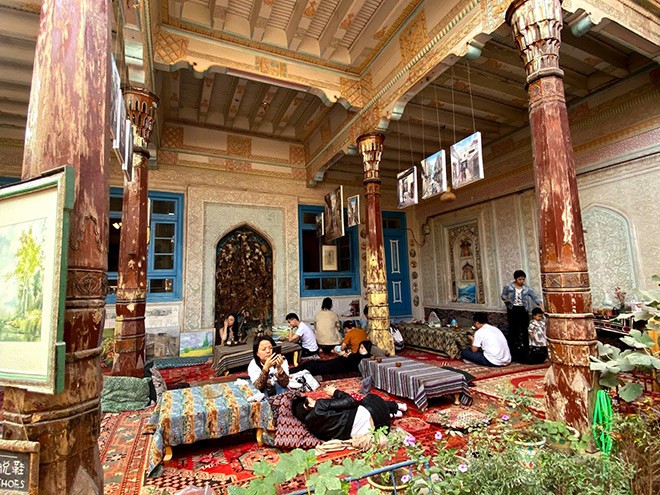 Visitors rest and relax in what was once a prayer room of a mosque in Kashgar in the western part of the Xinjiang Uighur Autonomous Region. (Atsushi Okudera)
Visitors rest and relax in what was once a prayer room of a mosque in Kashgar in the western part of the Xinjiang Uighur Autonomous Region. (Atsushi Okudera)
KASHGAR, China–At a domed building here in early October, the Islamic crescent symbol that indicated it had been a mosque had been removed.
The interior of the building had also been radically altered into a cafe.
What had once been a large prayer room had been turned into a rest area for tourists. Visitors who appeared to be Han drank tea or laid down to rest.
A source said the operator of the cafe was a Han from Guangdong province who began operations in May 2019 after rebuilding what had once been a house of worship.
One local resident was obviously upset that mosques in Kashgar were being turned into restaurants and rest areas.
“We are afraid to pray outside of our homes so we all gather at home to offer prayers,” the resident said.
UIGHUR MOSQUES TARGETED
Chinese authorities have moved to close a large number of mosques used by ethnic Uighurs in the Xinjiang Uighur Autonomous Region.
In both the region capital of Urumqi and Kashgar in the western part of the region, a number of mosques had been converted into cafes and other tourist destinations for Han Chinese.
And Beijing has not stopped at religious institutions. In what was described as a state project to turn the ancient city of Kashgar into a major tourist destination, parts of the city where homes and other buildings were constructed in the traditional Uighur style has been torn down and rebuilt over the past decade.
According to local residents, a large number of small and midsize mosques that were scattered around the old part of town have been closed over the past two to three years.
Another building about a minute’s walk from the former mosque also had part of its tower demolished and the former place of worship had also been turned into a cafe.
Another mosque in the eastern part of the residential district had been converted into a souvenir shop offering jade products.
Of the six mosques visited in the old city of Kashgar, five had been closed.
One Han operator of a cafe said the mosque was being rented from the local government. Mosques are apparently owned and managed by the local government and rented out for other purposes once they are closed.
A study by the Australian Strategic Policy Institute (ASPI) found a similar trend in other parts of the Xinjiang Uighur Autonomous Region.
In a report released in September, ASPI made a comparison using satellite images. A sample of 533 mosques out of the 24,000 or so in the region was selected. Since 2017, about 65 percent of the mosques had been either demolished or reconstructed for other purposes.
Violent clashes between Uighurs and Han in the past has led Beijing to strengthen its oversight of Islam. One method used is the Sinicization of the religion.
A researcher in a Communist Party organ in Xinjiang issued a report in 2015 that said, “The number of mosques in Xinjiang greatly exceeds the number needed for ordinary religious activities and some have become bases for separatists and radicals.”
Wang Wenbin, a Chinese Foreign Ministry spokesman, harshly criticized the ASPI report, calling it “an anti-China fabrication.”
SINICIZATION EFFORTS SEEN
A similar picture was also seen in Urumqi.
The metal gate to one mosque was closed and crescent symbols had been removed from the top of the columns that are an architectural feature of mosques. Peeking over the gate found construction materials and garbage strewn within the building.
A Uighur man who once prayed at the mosque said, “During the New Year, so many Muslims gathered there that some had to pray outside the building because not everyone could get in.”
According to a Communist Party official of the committee with jurisdiction over the district where the mosque is located, the building was designated in 2017 as dangerous because it did not have sufficient anti-quake measures. The official said the mosque was closed to protect the lives of residents.
Another mosque in the Shuimogou district had also been closed a few years ago because it was also classified as dangerous.
The ASPI study found that 35 percent of the mosques in Urumqi and 46 percent in Kashgar had been either demolished or reconstructed. The ratios were relatively low because domestic and foreign tourists often visit the two cities.
However, in rural areas in the north and south of the autonomous region about 80 percent of the mosques have been demolished.
A male ethnic Hui who said he was Muslim indicated that the mosque closures were meant to give Chinese authorities greater control.
“Closing the smaller mosques and forcing people to gather in larger mosques may make it easier to manage the people,” the man said.
There were other signs that Beijing was implementing Sinicization of the mosques.
One mosque in Urumqi prominently displayed not only the Chinese flag, but also displayed banners with the core values of the Chinese Communist Party.
Since the 2015 party decision to promote the Sinicization of religions, mosques have begun putting up banners calling for “ethnic solidarity” and pursuing “the Chinese dream.”
A visit to Hainan island in southern China in September led to a mosque that displayed not only a photo of Chinese President Xi Jinping, but also a sign urging visitors to read and study from his writings.
The intensified crackdown on Uighurs dates to around 2009 when about 2,000 people were killed or injured in violent clashes between Uighurs and Han Chinese in Urumqi. Subsequent violent acts in other parts of China were designated by authorities as terrorist acts plotted by those seeking Uighur independence.
Western nations have criticized the detention of Uighurs in what has been described as concentration camps as gross human rights violations.
https://www.asahi.com/ajw/articles/1382156
Furthermore, an online inquiry system is now being set up against Catholic, Islamic and Christian faith officials, which is supposed to unmask fraudulent fake monks and swindlers, although the Catholic underground church or other Christian and Islamic clerics are probably meant, with the exceptions of Buddhists and Daoists which seem apparently to be part of Chinese culture and heritage, but not Tibetan fake monks posing as living Buddhas- is that the Tibetan Panchem Lama child by the grace of the Dalai Lama who was kidnapped which might have escaped and is now haunting begging as a living Buddha? In addition, the Falun Gong also sees itself as Buddhist and Taoist, but this is understood as competition to the national people’s Buddhism of the CCP brand and as evil cult, and for the purpose of enlightenment on these issues there is already the Office 610.
“China opens inquiry system for information checking of Islamic, Catholic, Christian clergy
By Global Times Published: May 23, 2023 08:16 PM Updated: May 23, 2023 08:13 PM
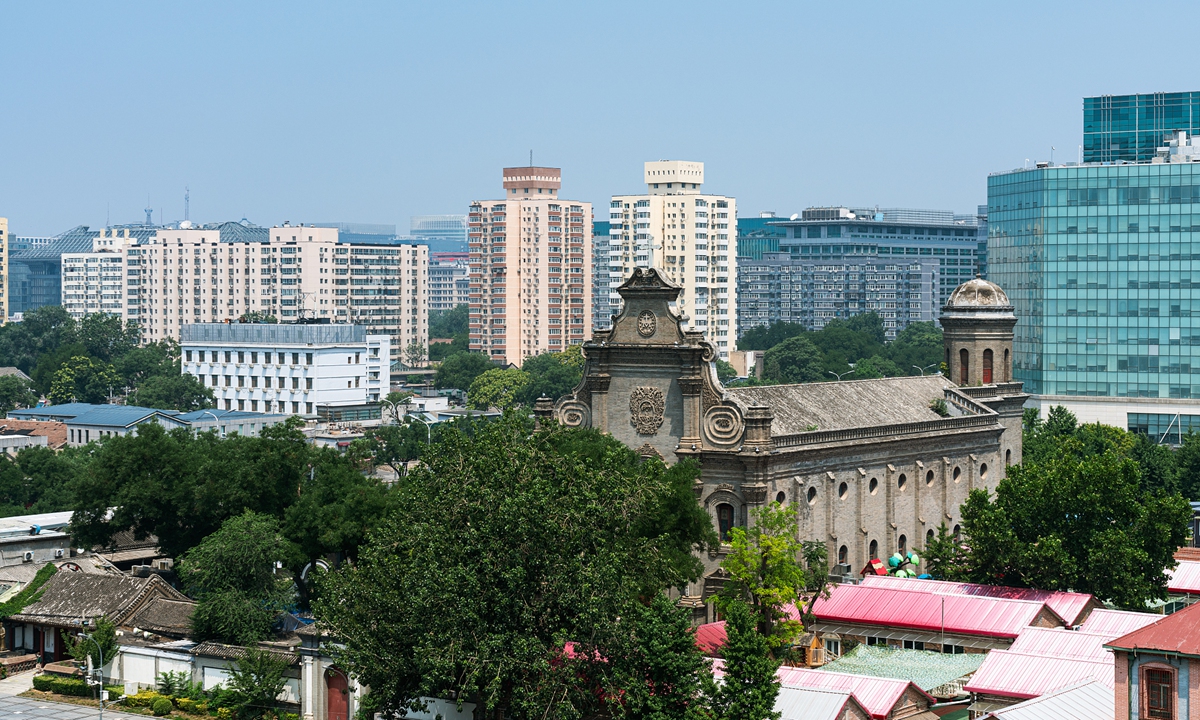
A photo of the outside of the Cathedral of the Immaculate Conception of the Archdiocese of Beijing taken on July 2, 2021. Photo: CFP
China has introduced the online inquiry system for the information checking of Islamic, Catholic and Christian clergy on Tuesday, a step to promote the openness of religious affairs as well as the identification and management of clergy.
Entering the websites of China Islamic Association, Catholic Church of China, China Christian Council and China’s State Bureau of Religious Affairs, the public can check the information of the clergy who have been identified and registered in accordance with the laws through the system after inputting two necessary message.
One is either the clergy’s name on the ID card or religious title. The other is either the clergy’s ID card number or the specific city where he or she is.
If the person was the clergy identified and registered in accordance with the laws, the information including the name, gender, photo, religious title, religious sect, clerical identity and clerical ID number will be presented. If not, the system will indicate that the person’s information was not found.
Similar information inquiry system for Buddhist and Taoist clergy has been launched in February to regulate the management on clerical personnel and fight against fraud cases related to fake religious personnel.
Fraud cases involving fake religious personnel have occurred from time to time over recent years, which has seriously tarnished the image of religious groups, disturbed social and public order, caused economic and property loss, and created an extremely bad social impact, Xinhua News Agency reported.
In 2021, Wang Xingfu in Jinan, East China’s Shandong Province, was sentenced to 25 years in prison after he illegally amassed nearly 200 million yuan ($29.11 million) and raped or molested several female disciples by faking an identity as a Living Buddha of Tibetan Buddhism.
Global Times
https://www.globaltimes.cn/page/202305/1291213.shtml
Furthermore, panda diplomacy. After the death of a Chinese panda in a US zoo during the balloon affair was inflated by the CCP as a national tragedy and a number of conspiracy theories about the „real cause of death“ were spread by angry nationalist Chinese netizens and in a kind of national act of repatriation the remaining panda from the US zoo, just as a freed, abused political prisoner was transferred back to China, just as a panda bear was brought home from Japan to the Middle Kingdom, the death of a 21-year-old panda in the zoo in Thailand is not taken as an opportunity by the CCP to question panda diplomacy towards Thailand or even to end it. Scholz and Baerbock should keep a close eye on the two Chinese pandas in the Berlin zoo, which Xi and Merkel visited with such media attention.
“21-year-old giant panda died of multiple organ failure in Thailand: experts
By Global Times Published: May 23, 2023 10:18 PM
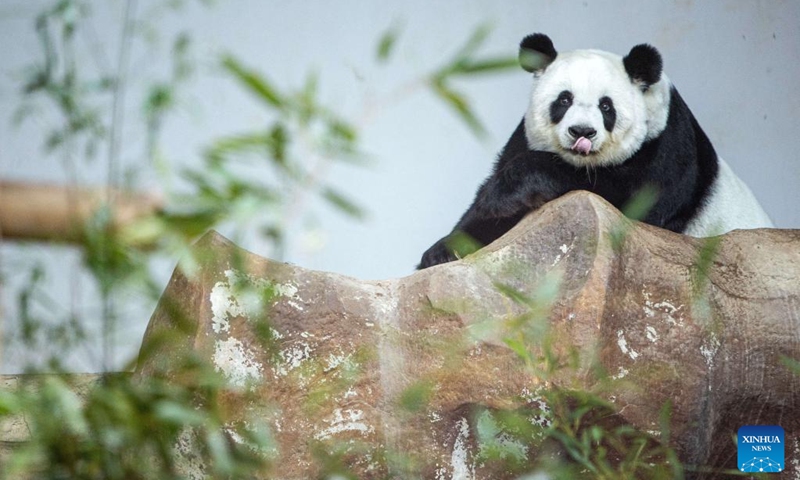
Giant panda Lin Hui rests at Chiang Mai Zoo in Chiang Mai, Thailand, Dec. 23, 2022. Lin Hui arrived in Chiang Mai on loan from China at the age of two in 2003. (Xinhua/Wang Teng)
Giant panda Lin Hui, the 21-year-old star attraction at Chiang Mai Zoo in Thailand, has died of multiple organ failure caused by atherosclerosis and embolism. The diagnosis was made after pathologic and etiological examination by a joint team of experts from China and Thailand, the China Conservation and Research Center for the Giant Panda said in a statement on Tuesday.
Lin Hui passed away on the morning of April 19 after fainting suddenly the day before. The zoo announced that Lin Hui first showed unusual symptoms on April 18 and was given a close examination, the Bangkok Post reported.
In a video taken by a tourist who visited the zoo on Tuesday, Lin Hui was seen lying feebly on the ground with blood stains on her nose and neck. She also seemed a bit nauseous, the tourist said in the video.
Upon learning the news, experts at the China Conservation and Research Center for the Giant Panda immediately reached the zoo to guide medical rescue efforts for the panda, but regrettably they were unable to save her life, Chinese Foreign Ministry spokesperson Wang Wenbin said at a press briefing.
The Chinese side attached great importance to the death of Lin Hui and urgently deployed experts to Thailand to investigate the cause of death, read the statement on the website of the China Conservation and Research Center for the Giant Panda.
Experts concluded that the elderly panda had died of multiple organ failure due to atherosclerosis and embolism. The nosebleed seen in the video was caused by hemangioma in her nasal cavity and contamination in other parts of her fur.
Chinese experts also conducted a thorough and detailed assessment of the facilities, medical team, food management, health system and diet management of the Chiang Mai Zoo where Lin Hui lived, and confirmed that it meets the requirements for giant panda breeding management and disease prevention and control.
Lin Hui was born in China on September 28, 2001. She was sent to Chiang Mai Zoo on October 12, 2003 as a goodwill ambassador between the two countries. She was scheduled to return to China this year.
Under the loving care of Chinese and Thai professionals, she has brought much joy to the Thai public over the years and has played an active role in promoting China-Thai cooperation in giant panda conservation and civil exchanges, Wang noted.
The Bangkok Post said Lin Hui was an instant star attraction. More than 7.4 million visitors have visited the zoo since October 2003 to see Lin Hui and Chuang Chuang, the two giant pandas on loan from China, according to the zoo director.
Since the launch of the China-Thailand Giant Panda research project 20 years ago, the two sides have achieved positive results in the protection and breeding of endangered species, as well as disease prevention and control, public education and other aspects, making positive contributions to the friendship between the two countries.
Both China and Thailand deeply regret the loss of Lin Hui, and the two countries will work together to deal with the aftermath of it, the China Conservation and Research Center for the Giant Panda noted.
Global Times
https://www.globaltimes.cn/page/202305/1291234.shtml
China’s culture war within the framework of the Global Civilizational Initiative does not remain unanswered: The anti-communist Buddhist mass sect Falungong, which also sees climate protection, feminism, wokeness and liberalism as neo-communism, under its leader Li Hongzhi, in turn, leads its own Global Civilizational Initiative using its cultural propaganda show Shen Yun, who is currently on a tour in Europe This time. also in Prague. When it comes to anti-communism, they get along quite well, and Shen Yun is not just a colorful cultural festival, but the Falun Gong’s own historiography and interpretation of how Chinese culture supposedly looks and should be authentic and real without the CCP’s suppression, and also the Faungong incorporates its own persecution by the CCP into its cultural propaganda pieces. In any case, a CEO and a mayor from the Pirate Party were won over as fans, which is widely trumpeted as some sort of a world-historical success:

On the afternoon of March 12, 2023, Shen Yun Global Arts held its final performance of the year at the Prague Convention Center in the Czech Republic, with tickets selling out in advance Four sold out performances
„Family Entrepreneur from Prague: „Shen Yun Dancers Are Energetic“
Epoch Times17. March 2023
The four Shen Yun performances in Prague were a resounding success. All shows were sold out and the audience loved it. This concludes Shen Yun Global Company’s European tour. Shen Yun International Company will kick off its European tour on March 24 in Basel. On the afternoon of March 12, 2023, New York-based Chinese artist group Shen Yun performed their fourth and final performance at the Prague Convention Center. Numerous celebrities were among the visitors. The audience was not only happy about the beautiful performance, but also about the return to traditional values. Group CEO: „Shen Yun Dancers Are Full of Energy“ Also among the audience were Dr. Oldřich Gojiš and his wife Eva Gojšová. Oldřich Gojiš is one of the two founders of the Czech dairy group Interlacto and the current CEO. The group ranks 27th in the Forbes ranking of Czech family businesses.

Oldřich Gojiš, founder and President of the Interlacto Group with his wife Eva Gojšová.
Gojiš said that while he has been to China and many other places around the world, seeing Shen Yun was a very special experience. „I like Shen Yun,“ he said. “I love the show, it’s wonderful and very interesting. I especially like your theme. Each (show) has a different background image, which is interesting and reflects the Chinese mentality. I feel very good after the performance.” The entrepreneur was impressed by the extraordinary performances of the Shen Yun performers and the high level of coordination of the whole team: „My favorite piece of the program was the one where the [Tibetan men] danced in the snowy mountains. It was alive and full of energy. I thought they worked very well together and were very good. I think there were 20 or 25 of them. The whole team was well put together. It was brilliant.” Gojiš praised Shen Yun for the good staging and ease of understanding: „Shen Yun did a great job presenting the individual pieces in an easy-to-understand way.“ His wife, Eva Gojšová, was also enthusiastic about Shen Yun: “Yes, I really liked it. The performance interested me because it got me thinking about a lot of questions that I was looking for answers to. I believe Shen Yun will bring viewers much, much more because it is a faith-themed story, just as it should be.” “I think Shen Yun is important for today’s society, especially in the present. It gets people to understand history and the present and to relate the two. This is very important.“ Mr. Gojiš added, „[Shen Yun] allows people to meet and it helps to understand other cultures.“ living tradition Family and tradition are very important to Matěj Ševčík, so it was even more important for him to watch Shen Yun with his family. After being there with his wife Lanka Novakova and daughter last year, this time he brought his parents and father-in-law with him.

Matěj Ševčík and his wife Lanka Novakova at the Prague Congress Center
„I really liked it, the colors were bright, the stories informative and interesting and I had a lot of fun watching,“ said the senior management consultant at PricewaterhouseCoopers Czech Republic after the presentation. “I saw Shen Yun before last year, so we came again today. My daughter is learning to dance so she had to see it again.“ Standing next to her father, his 10-year-old daughter Linda couldn’t wait to express how much she enjoyed Shen Yun. Ševčík finds Shen Yun’s mission to revive the divine heritage of 5,000 years of Chinese culture, which was destroyed by the Chinese Communist Party (CCP), very „powerful.“ „It’s a very strong message. I love her. We used to have problems with communism here too.”
For Ševčík, tradition also includes things like love and responsibility for the family. „It’s a strong and powerful association for me and I understand it very well. I come from the country where traditions are still well maintained and family is important. That’s the part of the show that really touches my heart, it’s really good.“ “Last year we came as a couple with our daughter. This year we brought the whole family including my parents and father-in-law. Only my son was too young to come and my mother in law couldn’t come because she was taking care of him.” Ševčík’s wife, Lanka Novakova, a physical education teacher, said, „My favorite dance at the end was ‚Song of the Snowy Mountains,‘ which was really, really good.“ She felt „energized“ with the Tibetan dance. She praised the synchronicity. “The dancers danced as a unit. They did the same moves at the same time, it was really wonderful.”
Almost moved to tears Michal Černý is a partner and director of purchases and sales at Keenspire Investments, which focuses, among other things, on property development and investments. „I love Shen Yun, it’s an excellent show,“ he told The Epoch Times. He thinks it is important for Shen Yun to revive traditional culture.

Michal Černý at Shen Yun in Prague.
„The design of the show, the costumes are very appealing, how do they do it?“ he asked. „The background animations were also very professional and at the same time had a strong cultural touch.“ The most moving part of the show for Černý was the dance „Water sleeves“. „The ladies were dancing with long sleeves and [seeing this scene] brought tears to my eyes.“ Seeing the long sleeves flapping on stage „I was so touched, it touched my heart“. Shen Yun presents audiences with the essence and values of 5,000 years of traditional Chinese culture.
Černý thinks these messages are important: “I think the messages you can feel from the show are firstly cultural in nature and secondly social. That is absolutely important.” Černý admires the energetic dance performances by Shen Yun artists. “I definitely feel a cultural connection here. I have often wondered what dedication and hard work is behind the performance. It’s incredible!“ Černý is happy to recommend Shen Yun to friends and family: „It’s undoubtedly a fascinating experience and I would definitely recommend them to see the show, it’s great to see [Shen Yun].“
Vice Mayor impressed by the depth
Chrudim Deputy Mayor Pavel Štěpánek and his wife Nikola said they enjoyed the performance very much. They were very impressed by the depth of the content. Pavel Štěpánek is a member of the Pirate Party of the Czech Republic and serves as the party’s national election coordinator. He is also the long-standing chairman and deputy mayor of the city of Chrudim. The city is located to the east of Prague, around a hundred kilometers from the capital. Štěpánek is responsible for the Department of Transport, Social Affairs and Construction. “Shen Yun has a very deep meaning for me. Whether it was the music or the dance, I was struck by the story of the dance and the depth of the performance.“
Regarding the play about the persecution of Falun Gong practitioners in China, which depicts the illegal organ harvesting, he said, „This dance drama , which shows the evils, touched me the most, it captivated me.” The politician regrets that Shen Yun cannot perform in China. “What Shen Yun is showing us here is a traditional Chinese art form. Shen Yun can tour the world but cannot perform in their own country.” His wife Nikola said the visit was a birthday present for her husband: „I was entranced by the performance and pleasantly surprised by the depth of the show. It was fascinating to see how the performance instilled values in the audience by transferring stories from traditional history to today’s world. It was a wonderful birthday present.”

Pavel Štěpánek, Deputy Mayor of Chrudim, and his wife Nikola.
Nikola also regretted that Shen Yun cannot perform in the mainland: “What surprised me and was new to me is that the Shen Yun artists are actually from New York and cannot perform there [mainland China]. . But what makes me happy is that they are touring the world and bringing an important message to people through this art form.”
This article originally appeared on epochtimes.com with the title:
Meanwhile, the first Asian-Jewish comic hero, whose origins go back to the oppression of the Jewish community in Kaifeng, China. Unfortunately, Global Time did not comment on this. Jews are almost non-existent in China, a minority among the minorities, and as long as the oppression of Chinese Jews in Kaifeng and China has not been linked to the Uyghurs, the Holocaust or the CCP’s religious oppression, this remains both under the perception and and intervention threshold. In addition, the oppression at that time could also be blamed on feudal warlords and ancient China or the Cultural Revolution.
“Asian-Jewish superhero fights 1970s Chinese mob in new comic book
First character of her kind in the medium battles to save parents, members of China’s Kaifeng Jewish community
By Julian Voloj 20 May 2023, 4:18 am

Leah Ai Tian is the hero of ‚The Last Jewish Daughter of Kaifeng.‘ (FairSquare Comics via JTA)
JTA — An independent comic book publisher that aims to promote diversity in comics is about to spotlight a historic new character: the Asian-Jewish Leah Ai Tian, also known as “The Last Jewish Daughter of Kaifeng.”
The character is the brainchild of Fabrice Sapolsky, co-founder of the Queens, New York-based FairSquare Comics, which works to “promote and give more exposure to immigrants, minorities and under-represented creators of the word.”
“The Last Jewish Daughter of Kaifeng,” which debuts June 7, is the latest installation of the Intertwined series of comics, which Sapolsky and fellow Frenchman Fred Pham Chuong started in 2017.
Israeli Caracal Brigade soldiers (IDF)- volunteer at Safra Children’s Hospital, Sheba
Leah, who made a brief appearance in the first Intertwined book, has the ability to manipulate anything water-based and travel through streams — not unlike a certain character in the popular TV show “Avatar: The Last Airbender.”
The book tells her complex origin story, which Sapolsky said is meant to “explain the reality of being a minority in a country that does not accept you as a minority.”
At first, Leah lives freely as a Jew in 1970s New York City — she wears a chai necklace, has opened a kosher Chinese restaurant and says her rabbi calls her powers “a blessing” from god. But the reader learns that she had left China to avoid a forced marriage to a mob lord who now terrorizes Kaifeng — a large city in eastern China home to the remnants of the country’s only native Jewish community.
That community, once thought to be at least a few thousand strong, by the time of Leah’s story was thought to be mostly dispersed or assimilated into the non-religious society of the Cultural Revolution. Leah returns home to try to save her parents and bring them to New York, where they could practice their religion freely.
Sapolsky’s interest in the Jewish community in Kaifeng dates back to the 1990s, when he was a teenager and his Jewish camp in France one year held “Kaifeng-themed” activities, meant to educate campers about Chinese Jews.
Born in France to a Sephardic mother from Algeria and an Ashkenazi father with roots in today’s Ukraine, his own background informed his interest in Jewish diversity.
“When working on the original concept of Intertwined, I knew we had to have a Jewish character, and there had never been an Asian Jewish character in comics,” Sapolsky said.
For Sapolsky, it was important to make Leah’s story “real, make it authentic, make it believable.” He talked to consultants about Kaifeng history and culture, making sure even the architecture depicted on the page was realistic.
“The two artists, Fei Chen and Ho Seng Hui, are from China and Malaysia, and never thought about Jews before this project, so they learned while drawing the book,” he said. “Will Torres, a Christian of Puerto Rican descent, helped with the inking, and the coloring was done by Argentine Exequiel Roel.”
The goal of the story was not only to refer to the minority experience in China — but also to the realities in the United States, Sapolsky’s adopted home.
“Unlike in France, where Jews are clearly defined as a minority, in this country they are widely perceived as simply white, which denies the diversity of Judaism,” he said.
https://www.timesofisrael.com/asian-jewish-superhero-fights-1970s-chinese-mob-in-new-comic-book/